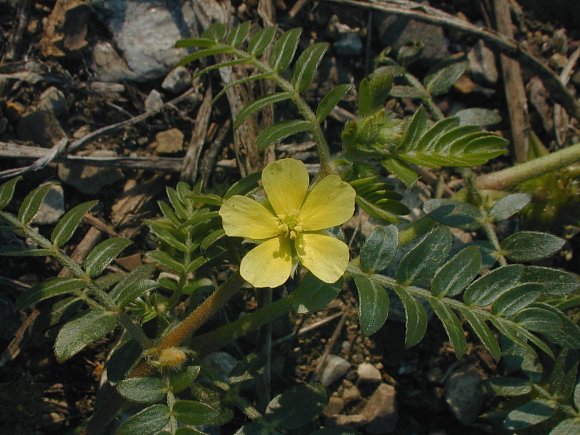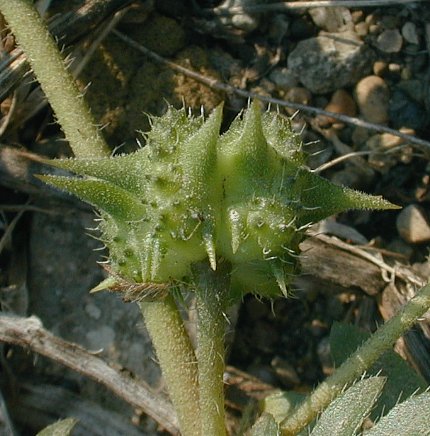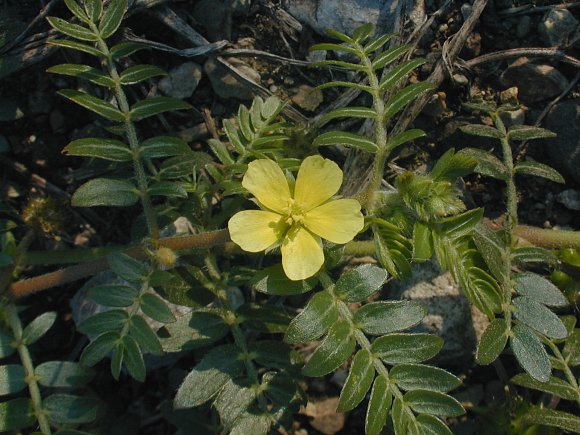Description: This plant is a summer annual that develops a mat of prostrate stems about 1-3' across; it branches frequently at the base, and occasionally elsewhere. The round stems are initially green, but quickly become brown; they are densely covered with short hairs and sparsely covered with long hairs. The compound leaves are evenly pinnate, consisting of 4-8 pairs of leaflets. Each compound leaf is about 2-4" in length, and it has a hairy central stalk. The dark green leaflets are up to ¾" long and ¼" across; they are, oblong, smooth along the margins, and sparsely to moderately hairy. There is a short petiole at the base of each leaflet. The flowers occur individually from the axils of the compound leaves on hairy pedicels about ½–¾" long. Each flower is about ½" across, consisting of 5 yellow petals, 5 triangular green sepals, 10 stamens with yellow anthers, and a pistil with a 5-lobed stigma. The petals are well-rounded and longer than the sepals.

The blooming
period occurs during the summer and early fall; a colony of plants will
continue to bloom for about 2-3 months. Each flower is replaced by a
spiny dry fruit (schizocarp) that divides into 5 segments. This fruit
is angular-globoid in shape and about 1" across; there are several
stout prickles, rows of spines, bumps, and ridges across its surface.
It is initially green, but later turns brown. Each segment of the fruit
contains several seeds. The root system consists of a stout taproot
that can extend several feet into the ground. This plant reproduces by
reseeding itself and often forms colonies at favorable sites.
Cultivation:
Puncture Vine is typically found at dry sunny sites with scant
vegetation; the soil usually contains an abundance of sand or gravel.
It forms root nodules with rhizobial bacteria and adds nitrogen to the
soil.

Range &
Habitat:
The non-native Puncture Vine occurs occasionally in scattered counties
across Illinois
(see Distribution
Map). It is originally from the Mediterranean area of
southern Europe and North Africa. Habitats include pastures, gravelly
areas along railroads (including the ballast), roadsides, and sandy
waste areas. Sometimes this species can spread aggressively in dry
overgrazed pastures, otherwise it isn't much of a problem in Illinois.
Faunal Associations:
Cattle refuse to graze in areas where this plant is abundant because of
the prickly fruits; sheep will eat the foliage, but it is somewhat
toxic to them and can cause swelling of the head. Light-skinned animals
often have photosensitive reactions after eating this plant. Little
else appears to be known about the floral-faunal relationships for this
species.

Photographic
Location:
A gravelly area along a railroad in Urbana, Illinois.
Comments:
The large prickly fruits have a formidable appearance; they are capable
of puncturing bicycle tires and can pierce the soles of some sandals
and shoes, hence the common name. Puncture Vine can be distinguished
from many other plants by its large prickly fruits, evenly pinnate
compound leaves, and prostrate habit. Some members of the Caltrop
family are native to the southern plains and desert southwest,
including Kallstroemia parviflora (Small-Flowered
Caltrop) and other members of this genus. Their flowers and foliage are
similar to those of Puncture Vine, but their fruits lack conspicuous
prickles.